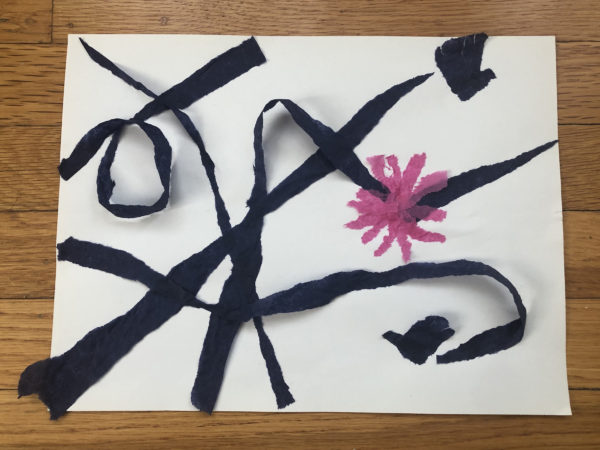Activity
Samurai as Cultivators of the Arts: Poetry, Theater, and Tea
Student Outcome : Students will learn the significance of balancing the military and cultural arts and write their own waka poem.

Standards (California Department of Education):
English/Language Arts: Reading Word Analysis: 6.1.1, 6.1.2, 6.1.4; Reading Comprehension 6.2.2; Literary Response 6.3.4, 6.3.7; 7.3.1; Writing Strategies 6.1.1; Listening and Speaking 6.1.6; History/Social Science: 7.7.5, 7.5.3, 7.5.4, 7.5.6; Visual/Performing Arts: Artistic Perception 6.1.3; Historical and Cultural Context 6.3.2; Connections, Relationships, Applications 6.5.1, 6.5.3
Materials:
Worksheets: Create a Waka Poem; Artwork (see “Downloads” above): Artrwork (see “Related Resources” below) Artwork: Archery practice; Dog chasing; Tea bowl with Crane Design; Noh robe; Writing box
Procedure:
- Read the following quote from the seventeenth century text, Buke Shohatto (Regulations for Military Houses): “The arts of peace and war, including archery and horsemanship, should be pursued single mindedly. From old the rule has been to practice the arts of peace on the left hand and the arts of war on the right; both must be mastered.” What does this quote tell you about the code of the samurai? Review the concepts of bu and bun.
- Describe how the cultural arts practiced by the samurai were often based on the same concepts as the military arts: self-discipline, loyalty, honor, self-cultivation, spirituality, and humility. Daimyo and their samurai practiced and were patrons of poetry, ceramics, Noh theater, ink painting, and the “Way of Tea” (Chado).
- Show the artwork of the archery drill known as Dog Chasing. Have the class look carefully at the image and talk about what they see. Read “What activity is taking place?” from the image description. (You may want to mention that the arrows were heavily padded and weren’t intended to harm the dogs.)
- The screen painting shows a scene based on an earlier time, when the activity shown was a way to develop important military skills. Why would this subject still be important during the peaceful Edo period when there wasn’t as much need for warriors to fight battles? (honors traditions of the samurai, requires a show of skill and discipline without the risks of war). The screen is elegant, with a gold background that indicates it was made for a wealthy patron, probably a high-ranking samurai. Notice the people in the stands? (common people, form of popular entertainment)
- Show the image of the scroll Archery practice. Ask students to describe what they see and speculate about the skill it would take to shoot an arrow at the target from a spirited, moving horse. Ask how this training could help them on the battlefield. Then, ask them to explain how this scroll is an example of bu and bun. There is a waka poem written at the right side, and a red fence that indicates that the scene takes place near a Shinto shrine. How do all the elements of the scene (the skill of the horseman, the poem, the courage of the man holding the target) demonstrate values of the samurai code? (courage, loyalty, spiritual faith, refinement in the arts, discipline)
- Read this description of bu and bun by a samurai scholar of the 1700s: “Culture and arms are like the two wings of a bird. Just as it is impossible to fly with one wing missing, if you have culture but no arms, people will slight you without fear, while if you have arms but no culture, people will be alienated by fear. Therefore, when you learn and practice both culture and arms, you demonstrate both intimidation and generosity, so people are friendly but also intimidated, and they will be obedient.”
- Review how the cultural and military arts interfaced, reinforced the warrior code, and permeated the daily lives of daimyo and their samurai.
- Give students the worksheet Create a Waka Poem. Have students write their own waka poem, and create a haiga, or illustration inspired by their waka.
Further Research:
Have students research other examples of the peaceful arts patronized by the daimyo and samurai.:
The Way of Tea (Chado)
Show the video, The Tearoom at the Asian Art Museum (see “Related Resources” below). After students watch the video, discuss how the “Way of Tea” illustrates the bun or peaceful arts.
Noh and Kyogen Theater
The performing arts were both enjoyed and performed by daimyo and their samurai. Have students research the history of Noh and Kyogen Theatre. View video examples (see “Related Resources” below) or research futher online. Compare and contrast the style of each type of performance.
Martial Arts
Ask if any of your students practice a martial art. If so, ask them to describe how it is an art form. Explain that during the Edo period, a time of peace, martial arts such as kendo (see “The Way of the Sword” video in “Related Resources” below), aikido, and judo became popular. They provided an opportunity for samurai to practice offensive and defensive moves that might be utilized on the battlefield, as an art form.





